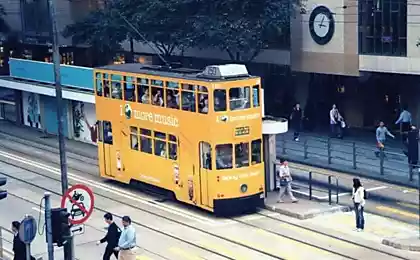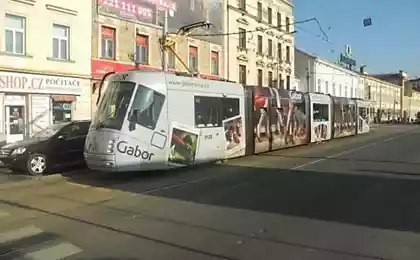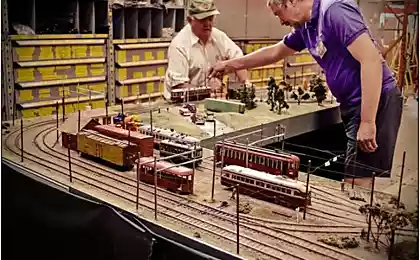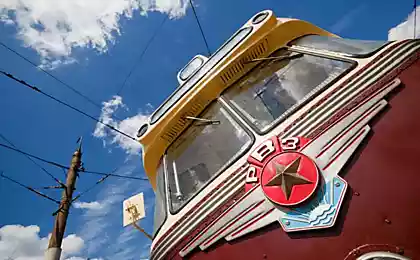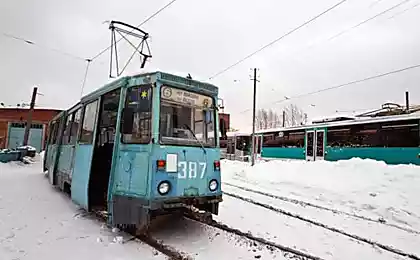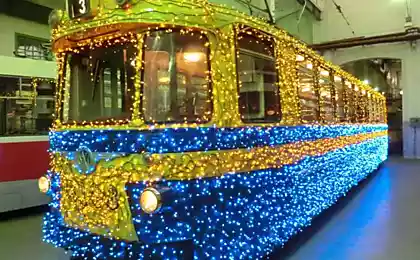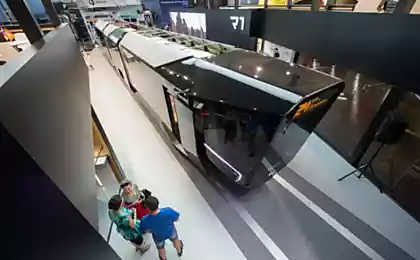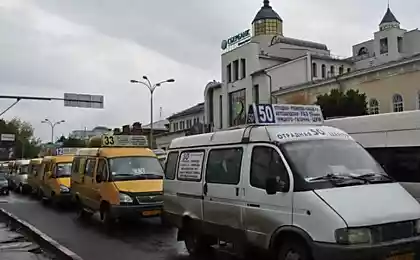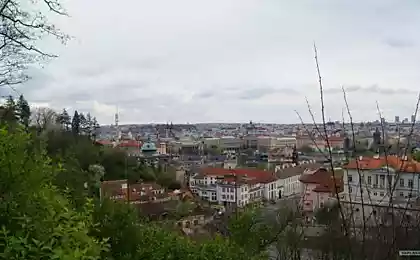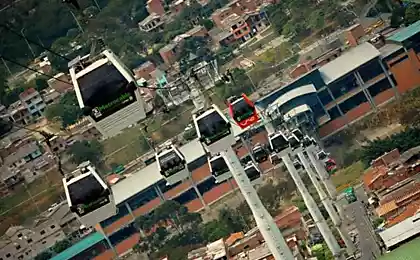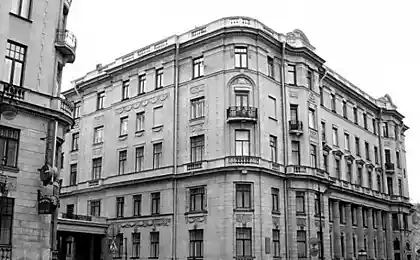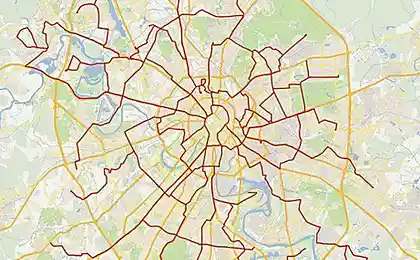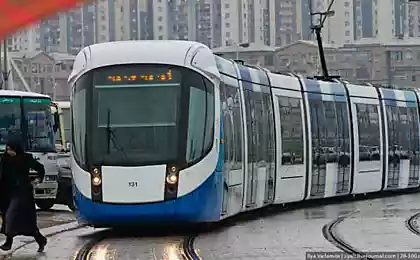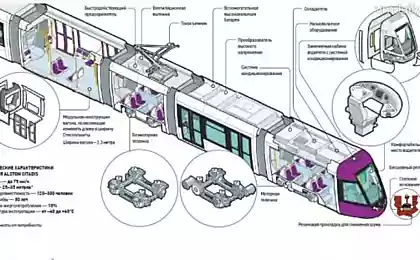1269
Trams rattle so Why?
Abstract: Many people resent the fact that the trams rattle, interfere with sleep, demolish buildings, make the jump cups in the cupboard, as well as contributing to the destruction of cars suspension accidents. In this connection, as a rule, it is proposed to "get rid of those already rumbling antediluvian monsters." I sometimes think that the confidence of our citizens treat headache - a top seller in treating would guillotine. Let's see why our trams are what is, and at the same time learn how our mayors care about their cities.
15 photos and letters via mymaster

To do this, first of all we have to talk a little bit about the structure of the tram, to understand what it makes sounds. Tram - a primitive electric device: to the wheels through a bunch of small mechanical motors are connected. Engines via a control system, which dispenses issued for their power, are connected to the contact network. Catenary wire is connected to positive substation, and rail - connected to its minus. The braking system of three levels, the easiest brake - shoe, full-time electrodynamic braking system - switching engine as a generator to "combustion energy" in the form of heat in the braking resistor. Emergency - electromagnetic brake primagnichivaet carriage to the rails. No explosive processes, no complex mechanics ...
What is there to make sounds? If we raise the tram over the rails and turn it on (an experimental model), we hear the sound of the motor (well, rotating the drill before drilling all heard - here the principle is the same), as well as the sound of the control system (rather nasty squeak, and sometimes even clicking of the relay contacts). In the old trams will be added to this case is quite natural fan, can be added to the system with pneumatic pump for the brake system - although you probably hear it in the trolley. Old Tram suspended in the air in the cabin will be noisier than the street ... But here is to put it on the track and there will be new sounds ...
Firstly, added rustling sound of friction of the pantograph on the catenary wire. Copper wire in pantograph has graphite or, more often, aluminum replaceable insert - so it's the sound of metal on metal friction. By the way, the wire above the rails suspended not in a straight line, and the "snake" - to contact strip wear evenly. On the rails the car decent shakes, and both vertically and horizontally. Because of this, it begins to "play" all the means at its ironwork and glass. Secondly, when the movement of the wheels due to the broadening of the track, the cart rolls from which it produces additional sounds. But the main thing - we have a lot of trams, with single suspending the body, they are very much wear out of rails and their own wheels. At the wheel cleaned with "flats", and the rail becomes wavy. As a result, non-circular wheel rides over uneven - wavy rail. Each passed "wave" on the rail for it is accompanied by a blow carts, so 20-ton tram makes a very strong sound, and in addition also has its weight in the rail, which passes it on to the entire rail-sleeper grid.
1.Volnoobrazny wear tram rails in Peterbruge
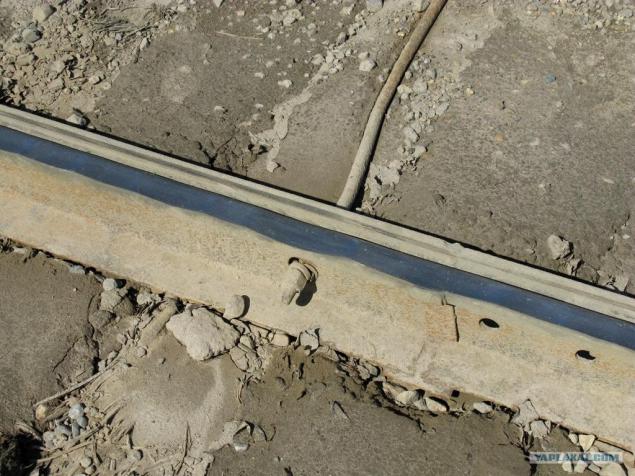
That is, it seems that the tram around the wheel, in fact, they are breaking the mold because of the pile of flats. Do you think that the rails in general lines - in fact, they have a corrugated surface, due to the fact that the wheels are wipe them recesses, creating a wavy wear. Finally, arrows and rail joints - the places where the tram wheels obvious hits, causing increased noise and vibration.
2.Lyska on the wheel

With the passage of our car the shooter uses not only a supporting part of the wheel, but also the comb, because the passage of such a transition arrow strikes occur very sonorous. Nowhere in the world such outdated design arrows are used. Of course, no one uses the arrow on the tram lines with manual transfer ("crowbar") - but in the city of Samara milionnike no audio auto arrows.
3. A typical example of the collapsed joint tram rails, Novosibirsk.
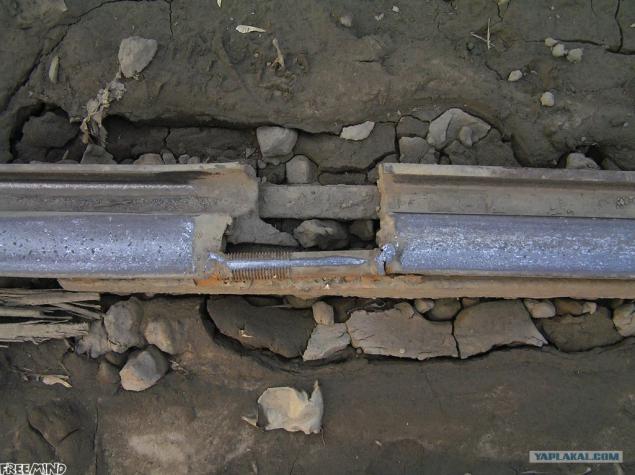
Wagon hammer blows of these rails, rail joints in parts where is a little deformed dispersed and destroyed. In the end, the edges break off, and the streetcar are welded to that anyhow. But in any case, through a rail strike on the car is transferred to the sleepers. If ties are attached to the rail hard enough, you have to punch the entire grid. There is about the same thing as if the fall in the rocking chair with the back: it's scary, but it does not hurt - a large area of impact it compensates. But we have used, as a rule, spike mounting rails, wherein the compound over time, greatly becomes loose, so strikes destroy a particular part of the way, bad damping bars. Since under the sleepers, as a rule, we simply ground, the blow came transferred to the sleepers on the ground on the foundations of adjacent buildings and underground utilities.
4. Repair of tram rails on Frunze Street Samara. Our days, our time.
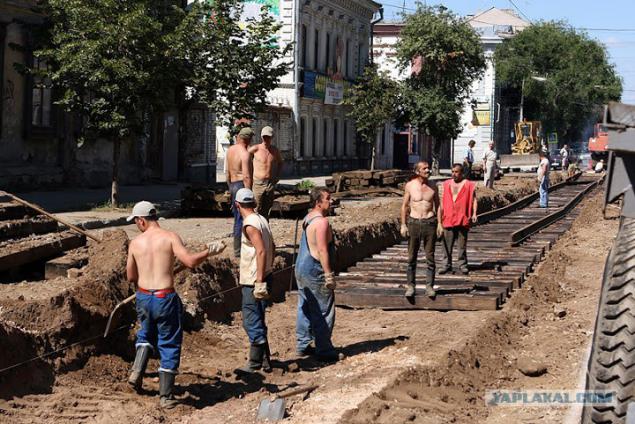
If the roads we see eye gouges and say "what the crap road!", In the case of tram rails most people do not notice their real condition. His but well aware tram services, and not to kill people off the track tramcar they limit the speed of traffic on damaged sections of track. For example - in a very prosperous by Russian standards Samara - a third tract has a speed limit of an emergency condition of the web. Think about it - a third of ways car rides like a turtle out of the fact that the ways in disrepair (!). In Voronezh, when there was talk of removing the tram tracks had a 100 percent speed limit due to an emergency condition of the web. This Voronezh did not discuss the question of what painting should be repaired, they said, "such a slow tram - it should be removed." Now there is a tram going to recover ...
So until closing system of any of the Voronezh tram he was able to travel at speeds up to 60 km / h: running cars was OK. Were defective rails. In the light rail line in Volgograd work great cars Tatra T3, which in most other cities, working on the lines of the conventional rail and honored citizens for "slow-moving". For Tatra T3 speed of 65 km / h - is the rate set by the, no problem with this kind of work have no cars. And here at the tracks - are. Therefore it is very amusing to hear the talk that "the city will purchase high-speed tram." NEVER light rail, are renovated path suitable for high-speed traffic. Particularly pleased Kazan - they regularly pretend that building new tram lines - thus putting wooden sleepers and fastened their crutches. At the same time they purchase "speed trams" and run them for the Universiade. This, of course, complete atrophy of the brain mayor ... every time speaking about "light rail", he presents himself as a complete ignoramus in urban governance.
The reason is that more than one mayor has not learned how to take pictures and pose for the cameras with normal renovated tram track, but with beautiful cars they succeed. As a result, the new cars produced at the broken rails with wavy fabric wear, the cars still go with speed limits, rumble in the ways and within a very short period of time, these new things are broken in the dust. Throughout Russian history, I have never heard of a single case in the country in which the mayor engaged in a focused renovation of tram rails. NEVER. Nearly all tram lines in Russia are built on technologies of 20-30-ies of the last century, with the majority of them are also in poor condition, even from the perspective of these technologies!
Let us now look at what the mayor would do a decent head in the right place.
Compare the level of uptake of our homeland mayor of Moscow, and the mayor of the provincial town of Constantine, located in the African Algeria, the example of the approach to the construction of tram lines ...
5. Laying the tram route to Protopopovskiy Lane, 2011, Moscow.
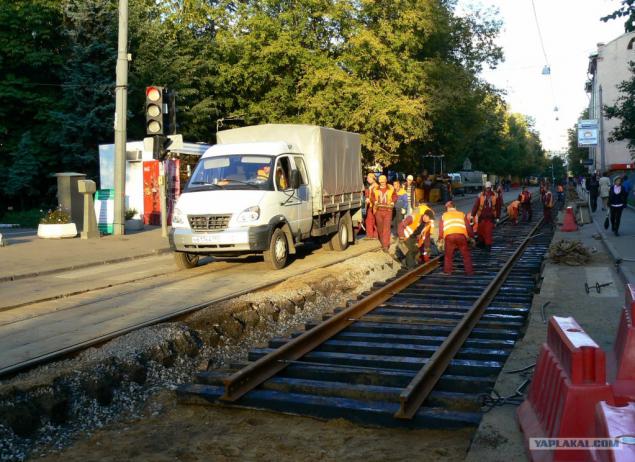
6. Laying tram tracks in the African provincial city of Constantine, the beginning of 2012.

Inquisitive eyes will notice some differences in technologies ... Since Arabs like to shoot against all the sun (I'm right procedure simply look for a picture to it a little design features could be seen the way), then the next I make out the technology to a successful photographer from Paris. She is there, the same as in Africa ... only the first frame is from Morocco, and then - to Paris.
7.

8. This is not the first stage has already captured - have already put geotextile, pour him a sand cushion that absorbs the load. She is very well designed - it depends on the thickness of the pile of site conditions. Further, it hosted iron-concrete foundation. Again, geotextiles, then a layer of concrete, which is laid woven metal mesh. It then re-poured concrete.
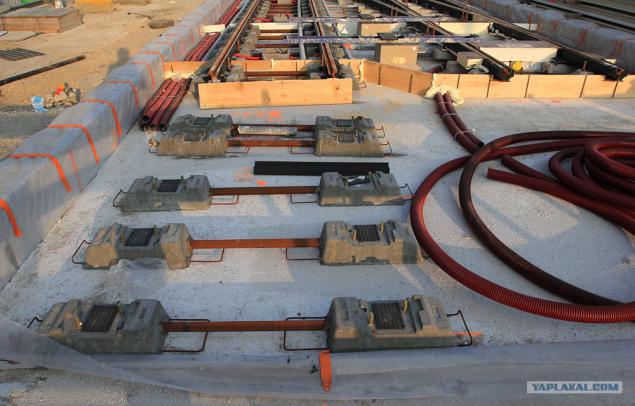
9. At the massive concrete foundation laid in addition to the pillow, begin installation of sleepers. As you can see, they are concrete, factory with a bunch of cunning inserts for proper mounting rail. It is very important to accurately gauge compliance. Between sleepers and rail is another gasket - this time rubber. You also see the cable wells, and in the background - rails, straightened by level. This is very important - all work on the unit performed by the way, with a tolerance of 2-3 mm.
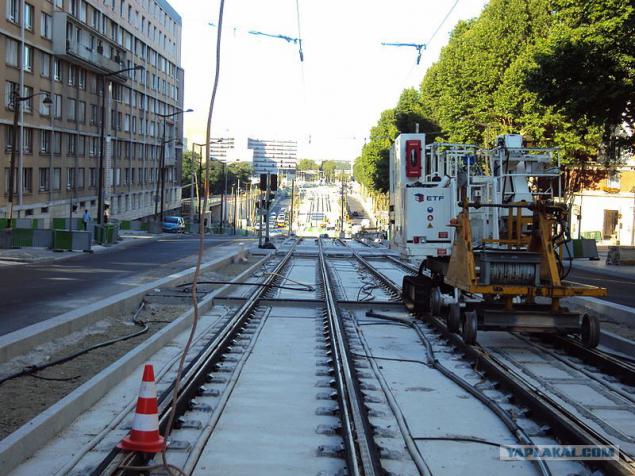
10. When everything is packed, you can pour the next layer of concrete and fix the base. There are laid communication cables and line control, as well as mounted vootvoda ditch. Maybe then I'll have something to talk about communication lines ... because the modern tram system has a very fine motion control. For example, moving the car controls the phases of traffic lights along the street. Tram stops along the line know the arrival time nearest tram. Manager knows the location of all trains on the line. Naturally, no one in the modern tram does not hand arrow ...
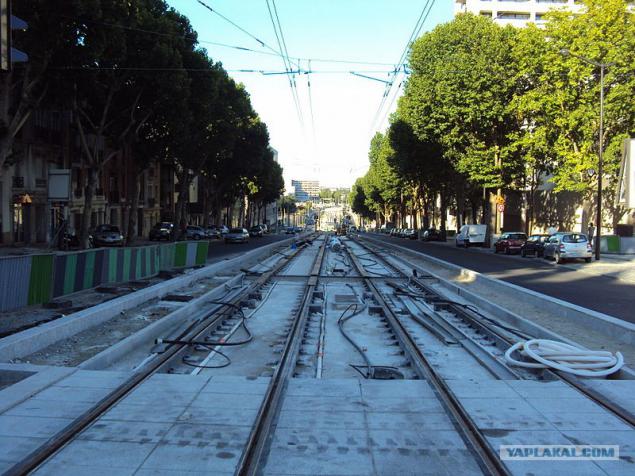
10. You can then move on to the mounting surface. The coating can be in such a technology be anything - large-block slabs or poured asphalt or paving slabs, paving stones ... but you can pitch, both artificial and natural. It does not matter, paving sections can be combined as you like within a single line. If you pay attention, you will notice that regardless of the type of coating on the sides of the rail laid rubber seals.
All joints are welded in this way, then carefully polished. Given the length tramlines problem with temperature compensation they practically do not arise. However, the technology allows the installation path if necessary, and make the temperature and expansion joints. Naturally, neither in Paris nor in Africa, no one takes the arrows scrap ... such technologies on the tramways were only in the less developed countries, such as Russia.
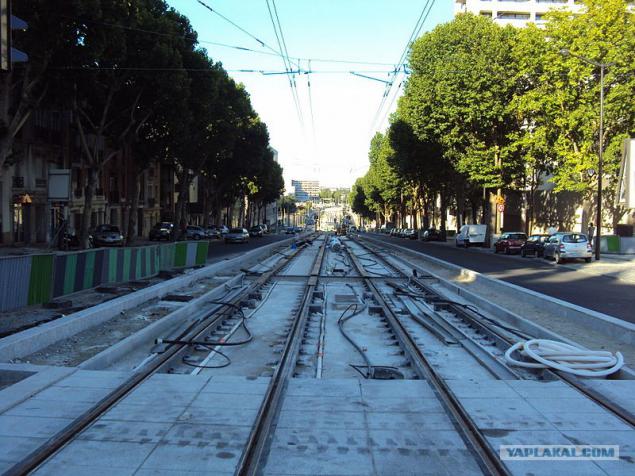
11. A return ka we do in Africa to evaluate the results - how looks finished tram line? This is not Algeria. This is another country - the Kingdom of Morocco, also a provincial city - Casablanca. In the Moroccan capital Rabat also has a tram line built on this technology. In Russia, these lines are not present anywhere, either in the province or in the capitals. I think you can see an eye that suspension of such a line is not going to break.
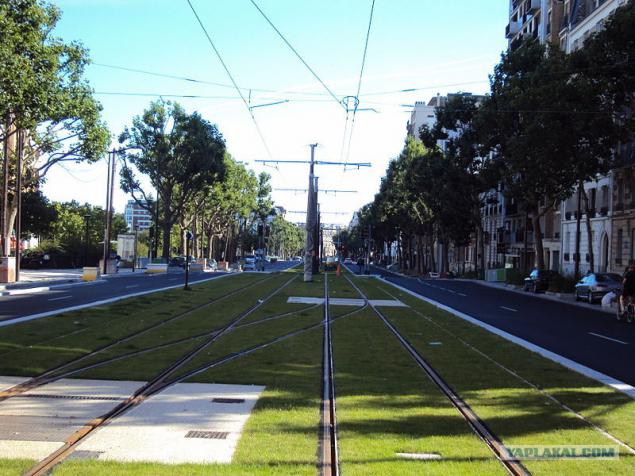
On the line laid in this manner, there is a multi-level vibration damping. The weight of the car depreciates sand cushion, which pushes not separate sleeper, and all the concrete base line. Sam rails supported by rubber gaskets. Naturally, the new trams with technology geared wheel otherwise interact with the rail.
As a result, here is a tram like the image produces the same amount of noise as the car. He never makes a sound when rolling on the tracks, all the noise - this job engines, control system and almost the loudest sound - the sound of friction of the pantograph on the wire. This tram does not create vibrations. Generally no. Absolutely. It can pass through a china shop, and there is not any one tremble saucer.
As you can see, between the realities of Russian cities and modern technologies used in the African countries, a huge gap. Maybe somehow catch up to us to help Skolkovo ... but while there is no direction on this subject, so first have to wait for his appearance. However, as I have already mentioned, we are all in poor condition, even from the standpoint of technology 20-ies of the last century. So what could make the mayors of our cities, if the tram do tomorrow?
Firstly, the need to deal with grinding track. For this way services usually have special relsoshlifovochnye wagons. This car with a whetstone in the cart, which like "irons" way, taking wave. This significantly reduces the noise from the movement of cars. Naturally this must be done not only on the old lines, but also to the newly renovated - but there it is necessary to grind is not the way, and joints. These cars are - but for their work need to spend money for their work, electricity, staff salaries ... therefore they usually do not leave the depot from the Soviet era. Here in Samara, for example, this car is - RSH-24. It should be at the depot dead weight.

Firstly, the need to deal with grinding track. For this way services usually have special relsoshlifovochnye wagons. This car with a whetstone in the cart, which like "irons" way, taking wave. This significantly reduces the noise from the movement of cars. Naturally this must be done not only on the old lines, but also to the newly renovated - but there it is necessary to grind is not the way, and joints. These cars are - but for their work need to spend money for their work, electricity, staff salaries ... therefore they usually do not leave the depot from the Soviet era. Here in Samara, for example, this car is - RSH-24. It should be at the depot dead weight.
13. Spetstelezhka railgrinder RSH-24 in Samara.
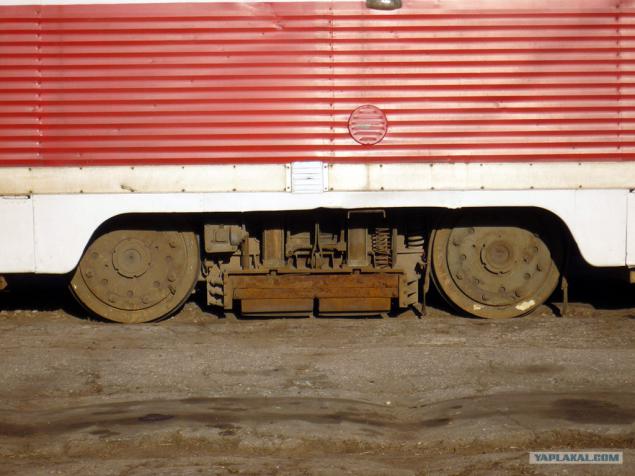
Allow to eliminate the special wagon, well, or at least substantially reduce the noise due to the wave-like wear rails. This, by the way, makes it possible to divide smaller cars, which gives savings on repairs. But who does it - savings - can be considered? .. Next is the important issue - turning the wheel pair in the depot. For this there are machines ... the car is removed from the carriages, carts disassembled, separating the wheel sets, and those are on the machine. The machine grinds off mounds, all going back. If you have nothing to grind, then put the new tires wheels.
So, as you can see, the tram can also be "pereobut" :) Only now I think motorists will remember how it is hard to change tires - seems to be necessary, but expensive and troublesome ... That's just as well in the tram depot to decide whether to replace the shroud and wheels turning of wheel sets: expensive (but does not allocate money City Hall) and troublesome (there are more priority issues, which take maintenance personnel). As a result, the trams are driven through the city with good flats, so it is not known that rattle and shake on the inside there is a feeling that he was on the ride "roller coaster».
How to be? The subway, which is in contrast to the tram usually contain more or less good condition, it is solved like this streaming machine for turning of wheel sets:
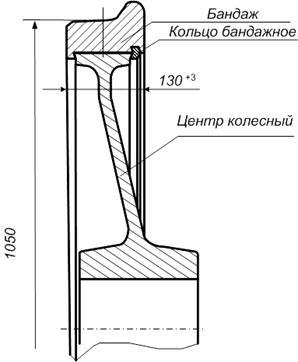
The car comes to a truck on the machine, and the work begins. This allows not much mutilated in solving trivial everyday tasks of turning of wheel sets. Well, the timely replacement of the shroud - a sacred thing, and if it is not done, then we have to sin with square wheels rumble across the city.
Another theme that is feasible even beggar mayor - is welding joints ways. Welding wagons usually also equipped in each sector ... only on their application also save. Plus there are many types of welding set, we use the most primitive way ... as a result of reduced, as in the photo from Novosibirsk above. This, of course, in such areas and broken down cars rattle. This, naturally, could not stack - if even for existing routes followed and cared for. I note that I have now listed - a penny work does not require the introduction of complex African technology.
And now - the most interesting. I picked up the papers and read in the concept of preparations for the 2018 World Cup in Samara that public transport used to travel around the city Samara, 94, 7% of people (page 12). There's also stated that it is for transportation by trams 43% of all passenger traffic.
Source:
15 photos and letters via mymaster

To do this, first of all we have to talk a little bit about the structure of the tram, to understand what it makes sounds. Tram - a primitive electric device: to the wheels through a bunch of small mechanical motors are connected. Engines via a control system, which dispenses issued for their power, are connected to the contact network. Catenary wire is connected to positive substation, and rail - connected to its minus. The braking system of three levels, the easiest brake - shoe, full-time electrodynamic braking system - switching engine as a generator to "combustion energy" in the form of heat in the braking resistor. Emergency - electromagnetic brake primagnichivaet carriage to the rails. No explosive processes, no complex mechanics ...
What is there to make sounds? If we raise the tram over the rails and turn it on (an experimental model), we hear the sound of the motor (well, rotating the drill before drilling all heard - here the principle is the same), as well as the sound of the control system (rather nasty squeak, and sometimes even clicking of the relay contacts). In the old trams will be added to this case is quite natural fan, can be added to the system with pneumatic pump for the brake system - although you probably hear it in the trolley. Old Tram suspended in the air in the cabin will be noisier than the street ... But here is to put it on the track and there will be new sounds ...
Firstly, added rustling sound of friction of the pantograph on the catenary wire. Copper wire in pantograph has graphite or, more often, aluminum replaceable insert - so it's the sound of metal on metal friction. By the way, the wire above the rails suspended not in a straight line, and the "snake" - to contact strip wear evenly. On the rails the car decent shakes, and both vertically and horizontally. Because of this, it begins to "play" all the means at its ironwork and glass. Secondly, when the movement of the wheels due to the broadening of the track, the cart rolls from which it produces additional sounds. But the main thing - we have a lot of trams, with single suspending the body, they are very much wear out of rails and their own wheels. At the wheel cleaned with "flats", and the rail becomes wavy. As a result, non-circular wheel rides over uneven - wavy rail. Each passed "wave" on the rail for it is accompanied by a blow carts, so 20-ton tram makes a very strong sound, and in addition also has its weight in the rail, which passes it on to the entire rail-sleeper grid.
1.Volnoobrazny wear tram rails in Peterbruge

That is, it seems that the tram around the wheel, in fact, they are breaking the mold because of the pile of flats. Do you think that the rails in general lines - in fact, they have a corrugated surface, due to the fact that the wheels are wipe them recesses, creating a wavy wear. Finally, arrows and rail joints - the places where the tram wheels obvious hits, causing increased noise and vibration.
2.Lyska on the wheel

With the passage of our car the shooter uses not only a supporting part of the wheel, but also the comb, because the passage of such a transition arrow strikes occur very sonorous. Nowhere in the world such outdated design arrows are used. Of course, no one uses the arrow on the tram lines with manual transfer ("crowbar") - but in the city of Samara milionnike no audio auto arrows.
3. A typical example of the collapsed joint tram rails, Novosibirsk.

Wagon hammer blows of these rails, rail joints in parts where is a little deformed dispersed and destroyed. In the end, the edges break off, and the streetcar are welded to that anyhow. But in any case, through a rail strike on the car is transferred to the sleepers. If ties are attached to the rail hard enough, you have to punch the entire grid. There is about the same thing as if the fall in the rocking chair with the back: it's scary, but it does not hurt - a large area of impact it compensates. But we have used, as a rule, spike mounting rails, wherein the compound over time, greatly becomes loose, so strikes destroy a particular part of the way, bad damping bars. Since under the sleepers, as a rule, we simply ground, the blow came transferred to the sleepers on the ground on the foundations of adjacent buildings and underground utilities.
4. Repair of tram rails on Frunze Street Samara. Our days, our time.

If the roads we see eye gouges and say "what the crap road!", In the case of tram rails most people do not notice their real condition. His but well aware tram services, and not to kill people off the track tramcar they limit the speed of traffic on damaged sections of track. For example - in a very prosperous by Russian standards Samara - a third tract has a speed limit of an emergency condition of the web. Think about it - a third of ways car rides like a turtle out of the fact that the ways in disrepair (!). In Voronezh, when there was talk of removing the tram tracks had a 100 percent speed limit due to an emergency condition of the web. This Voronezh did not discuss the question of what painting should be repaired, they said, "such a slow tram - it should be removed." Now there is a tram going to recover ...
So until closing system of any of the Voronezh tram he was able to travel at speeds up to 60 km / h: running cars was OK. Were defective rails. In the light rail line in Volgograd work great cars Tatra T3, which in most other cities, working on the lines of the conventional rail and honored citizens for "slow-moving". For Tatra T3 speed of 65 km / h - is the rate set by the, no problem with this kind of work have no cars. And here at the tracks - are. Therefore it is very amusing to hear the talk that "the city will purchase high-speed tram." NEVER light rail, are renovated path suitable for high-speed traffic. Particularly pleased Kazan - they regularly pretend that building new tram lines - thus putting wooden sleepers and fastened their crutches. At the same time they purchase "speed trams" and run them for the Universiade. This, of course, complete atrophy of the brain mayor ... every time speaking about "light rail", he presents himself as a complete ignoramus in urban governance.
The reason is that more than one mayor has not learned how to take pictures and pose for the cameras with normal renovated tram track, but with beautiful cars they succeed. As a result, the new cars produced at the broken rails with wavy fabric wear, the cars still go with speed limits, rumble in the ways and within a very short period of time, these new things are broken in the dust. Throughout Russian history, I have never heard of a single case in the country in which the mayor engaged in a focused renovation of tram rails. NEVER. Nearly all tram lines in Russia are built on technologies of 20-30-ies of the last century, with the majority of them are also in poor condition, even from the perspective of these technologies!
Let us now look at what the mayor would do a decent head in the right place.
Compare the level of uptake of our homeland mayor of Moscow, and the mayor of the provincial town of Constantine, located in the African Algeria, the example of the approach to the construction of tram lines ...
5. Laying the tram route to Protopopovskiy Lane, 2011, Moscow.

6. Laying tram tracks in the African provincial city of Constantine, the beginning of 2012.

Inquisitive eyes will notice some differences in technologies ... Since Arabs like to shoot against all the sun (I'm right procedure simply look for a picture to it a little design features could be seen the way), then the next I make out the technology to a successful photographer from Paris. She is there, the same as in Africa ... only the first frame is from Morocco, and then - to Paris.
7.

8. This is not the first stage has already captured - have already put geotextile, pour him a sand cushion that absorbs the load. She is very well designed - it depends on the thickness of the pile of site conditions. Further, it hosted iron-concrete foundation. Again, geotextiles, then a layer of concrete, which is laid woven metal mesh. It then re-poured concrete.

9. At the massive concrete foundation laid in addition to the pillow, begin installation of sleepers. As you can see, they are concrete, factory with a bunch of cunning inserts for proper mounting rail. It is very important to accurately gauge compliance. Between sleepers and rail is another gasket - this time rubber. You also see the cable wells, and in the background - rails, straightened by level. This is very important - all work on the unit performed by the way, with a tolerance of 2-3 mm.

10. When everything is packed, you can pour the next layer of concrete and fix the base. There are laid communication cables and line control, as well as mounted vootvoda ditch. Maybe then I'll have something to talk about communication lines ... because the modern tram system has a very fine motion control. For example, moving the car controls the phases of traffic lights along the street. Tram stops along the line know the arrival time nearest tram. Manager knows the location of all trains on the line. Naturally, no one in the modern tram does not hand arrow ...

10. You can then move on to the mounting surface. The coating can be in such a technology be anything - large-block slabs or poured asphalt or paving slabs, paving stones ... but you can pitch, both artificial and natural. It does not matter, paving sections can be combined as you like within a single line. If you pay attention, you will notice that regardless of the type of coating on the sides of the rail laid rubber seals.
All joints are welded in this way, then carefully polished. Given the length tramlines problem with temperature compensation they practically do not arise. However, the technology allows the installation path if necessary, and make the temperature and expansion joints. Naturally, neither in Paris nor in Africa, no one takes the arrows scrap ... such technologies on the tramways were only in the less developed countries, such as Russia.

11. A return ka we do in Africa to evaluate the results - how looks finished tram line? This is not Algeria. This is another country - the Kingdom of Morocco, also a provincial city - Casablanca. In the Moroccan capital Rabat also has a tram line built on this technology. In Russia, these lines are not present anywhere, either in the province or in the capitals. I think you can see an eye that suspension of such a line is not going to break.

On the line laid in this manner, there is a multi-level vibration damping. The weight of the car depreciates sand cushion, which pushes not separate sleeper, and all the concrete base line. Sam rails supported by rubber gaskets. Naturally, the new trams with technology geared wheel otherwise interact with the rail.
As a result, here is a tram like the image produces the same amount of noise as the car. He never makes a sound when rolling on the tracks, all the noise - this job engines, control system and almost the loudest sound - the sound of friction of the pantograph on the wire. This tram does not create vibrations. Generally no. Absolutely. It can pass through a china shop, and there is not any one tremble saucer.
As you can see, between the realities of Russian cities and modern technologies used in the African countries, a huge gap. Maybe somehow catch up to us to help Skolkovo ... but while there is no direction on this subject, so first have to wait for his appearance. However, as I have already mentioned, we are all in poor condition, even from the standpoint of technology 20-ies of the last century. So what could make the mayors of our cities, if the tram do tomorrow?
Firstly, the need to deal with grinding track. For this way services usually have special relsoshlifovochnye wagons. This car with a whetstone in the cart, which like "irons" way, taking wave. This significantly reduces the noise from the movement of cars. Naturally this must be done not only on the old lines, but also to the newly renovated - but there it is necessary to grind is not the way, and joints. These cars are - but for their work need to spend money for their work, electricity, staff salaries ... therefore they usually do not leave the depot from the Soviet era. Here in Samara, for example, this car is - RSH-24. It should be at the depot dead weight.

Firstly, the need to deal with grinding track. For this way services usually have special relsoshlifovochnye wagons. This car with a whetstone in the cart, which like "irons" way, taking wave. This significantly reduces the noise from the movement of cars. Naturally this must be done not only on the old lines, but also to the newly renovated - but there it is necessary to grind is not the way, and joints. These cars are - but for their work need to spend money for their work, electricity, staff salaries ... therefore they usually do not leave the depot from the Soviet era. Here in Samara, for example, this car is - RSH-24. It should be at the depot dead weight.
13. Spetstelezhka railgrinder RSH-24 in Samara.

Allow to eliminate the special wagon, well, or at least substantially reduce the noise due to the wave-like wear rails. This, by the way, makes it possible to divide smaller cars, which gives savings on repairs. But who does it - savings - can be considered? .. Next is the important issue - turning the wheel pair in the depot. For this there are machines ... the car is removed from the carriages, carts disassembled, separating the wheel sets, and those are on the machine. The machine grinds off mounds, all going back. If you have nothing to grind, then put the new tires wheels.
So, as you can see, the tram can also be "pereobut" :) Only now I think motorists will remember how it is hard to change tires - seems to be necessary, but expensive and troublesome ... That's just as well in the tram depot to decide whether to replace the shroud and wheels turning of wheel sets: expensive (but does not allocate money City Hall) and troublesome (there are more priority issues, which take maintenance personnel). As a result, the trams are driven through the city with good flats, so it is not known that rattle and shake on the inside there is a feeling that he was on the ride "roller coaster».
How to be? The subway, which is in contrast to the tram usually contain more or less good condition, it is solved like this streaming machine for turning of wheel sets:

The car comes to a truck on the machine, and the work begins. This allows not much mutilated in solving trivial everyday tasks of turning of wheel sets. Well, the timely replacement of the shroud - a sacred thing, and if it is not done, then we have to sin with square wheels rumble across the city.
Another theme that is feasible even beggar mayor - is welding joints ways. Welding wagons usually also equipped in each sector ... only on their application also save. Plus there are many types of welding set, we use the most primitive way ... as a result of reduced, as in the photo from Novosibirsk above. This, of course, in such areas and broken down cars rattle. This, naturally, could not stack - if even for existing routes followed and cared for. I note that I have now listed - a penny work does not require the introduction of complex African technology.
And now - the most interesting. I picked up the papers and read in the concept of preparations for the 2018 World Cup in Samara that public transport used to travel around the city Samara, 94, 7% of people (page 12). There's also stated that it is for transportation by trams 43% of all passenger traffic.
Source:
Pay attention! Made in Germany!
I do not like the pits and srach in the city? Suitcase, train station ..
